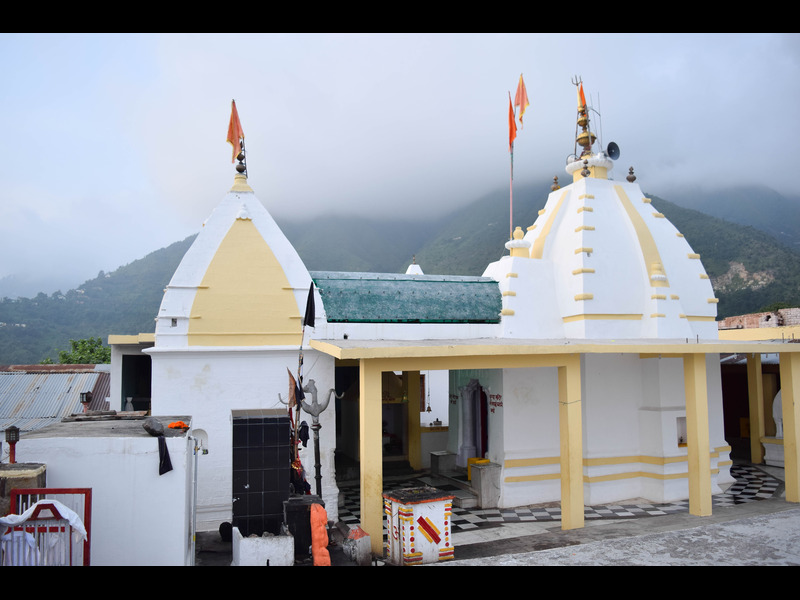Sudh Mahadev- a Shiva temple in Patnitop area of Jammu region is one of the oldest religious destinations of J&K besides also being the oldest hill station and tourist destination. Devotees of Lord Shiva in large numbers from across the country and world visit this place to pay obeisance and enjoy the scenic beauty.
Sudh Mahadev is a Shiva temple complex which is considered to be at least 3,000 years old. It comes within the jurisdiction of the Patnitop Development Authority (PDA), and is about 42 kilometers away from Patnitop and 112 kilometers from Jammu.
The temple is surrounded by many other attractions with scenic beauty, including the Devak stream, which originates at Sudh Mahadev and disappears into the rocks downstream, and the spring called Paap Nashni Bowli, which is believed to wash away sins.
According to Hindu mythology, the temple is named after a demon named Sudheet who visited Goddess Parvati.
When Parvati saw Sudheet, she screamed, and Lord Shiva killed him with his trident. Shiva then realized his mistake and resurrected Sudheet, and the temple was named after him.
Another legend says that Shiva promised Parvati that he would always be at Sudh Mahadev, and that people could come here to wash away their sins.
The temple complex hosts many festivals and events throughout the year, including Jhiri Mela and Sawan Mela.
An annual festival is organized during the Karthik Purnima, or late autumn full moon, to commemorate the martyrdom of Baba Jittoo, who is revered for standing up against unfair treatment of the peasantry during feudal times.
A festival-Sawan Mela tis held on the full moon of the month of Saawan, when people from all over the country come to Sudh Mahadev. The festival includes music and dance performances.
On the third day of the festival, a wrestling match called a Dangal is also held in the Choughan of Sudh Mahadev, with wrestlers from Jammu and Kashmir and Punjab participate in the competition.
Sudhmahadev is a picturesque valley at the foothills of Dhar Shivgarh in Tehsil Chenani of Jammu province. From ancient times, Sudhmahadev is known as Maha Tirtha of Duggar, connected with the glories of Lord Shiva.
This region is also known as Dev Bhoomi of Duggar, as holy Devika rivulet appears here to wash the sins of mankind.
In Sudhmahadev-Mantalai religious pilgrimage circuit, many prominent Shiv-Parvati temples are situated with Shri Shool Panishwar Shivji Maharaj temple Sudhmahadev as the epicenter of these “Panjtirthi” group of temples.
With a deep rooted religious background, Sudhmahadev-Mantalai area is also known as the connecting link between medieval and modern history of the region.
Chandel dynasty kings from Chanderi, Bundelkhand, M.P established their kingdom in this area in early ninth century with capital at Mantalai (which was thereafter shifted to Chenani) and ruled till 1947-48.
These kings left their footprints in this area as unexplored archeological sites at Mantalai, Garh Barkot and many other forts and palaces in and around Chenani, which can be a source of historical research.
With lush green Deodar forests, high mountains, holy rivulets, waterfalls and grasslands, Sudhmahadev area has matchless natural beauty for general and adventure tourism etc.
The people of Chenani state are known to live their life to the fullest in a joyous atmosphere. The celebration of melas, festivals, kudds and jattars have remained an integral part of the social and cultural life of Chenani.
Throughout the year, these events are celebrated with great pomp and show. In the long list of these cultural events, Sudhmahadev mela is one of the oldest, connected with religious paramountcy of Shaivism in this area.
On the first day of the Mela, the first place to be visited is Gouri Kund, which is Temple of “Goddess Parvati” situated in the coldest hilly belt of Sudhmahadev area.
The grand old temple is built near a holy stream where devotees take bath and offer pooja in the temple.
It is believed that here Goddess Parvati used to worship to get married to Lord Shiva. After holy bath and pooja at Gouri Kund, the devotees in thousands reach Sudhmahadev in the night and continue reaching without break till morning. The bazaars are decorated and some people provide free langer facilities at Gouri Kund, Sudhmahadev and Mantalai.
This temple complex is said to be constructed some one thousand years ago, but it was modified and renovated many times by the Rajas of Chenani to give it its present shape.
Adjacent to the temple, there is one ‘Haweli’ of Rajas of Chenani. The Temple has a large number of Samadhis of Nath sadhus.
Another important place in this temple is 1000 years old continuously burning “Dhooni”. It is astonishing to note that although ash is never taken out from the Dhooni, yet the ash level of ‘Dhooni’ remains the same.
The logs of wood keep on burning day and night. Inside the temple complex, there is a beautiful temple of Guru Gorakh Nath Ji and also a black idol of Bharoo Nath ji.
It is also worth mentioning that in the treasure of Shiv Temple, there lies one unidentified jewel called “Shiv-Rudri” which is kept open for darshan during the mela days. Inside the temple complex, there is a large trident of Lord Shiva which is buried deep with the upper end visible.









